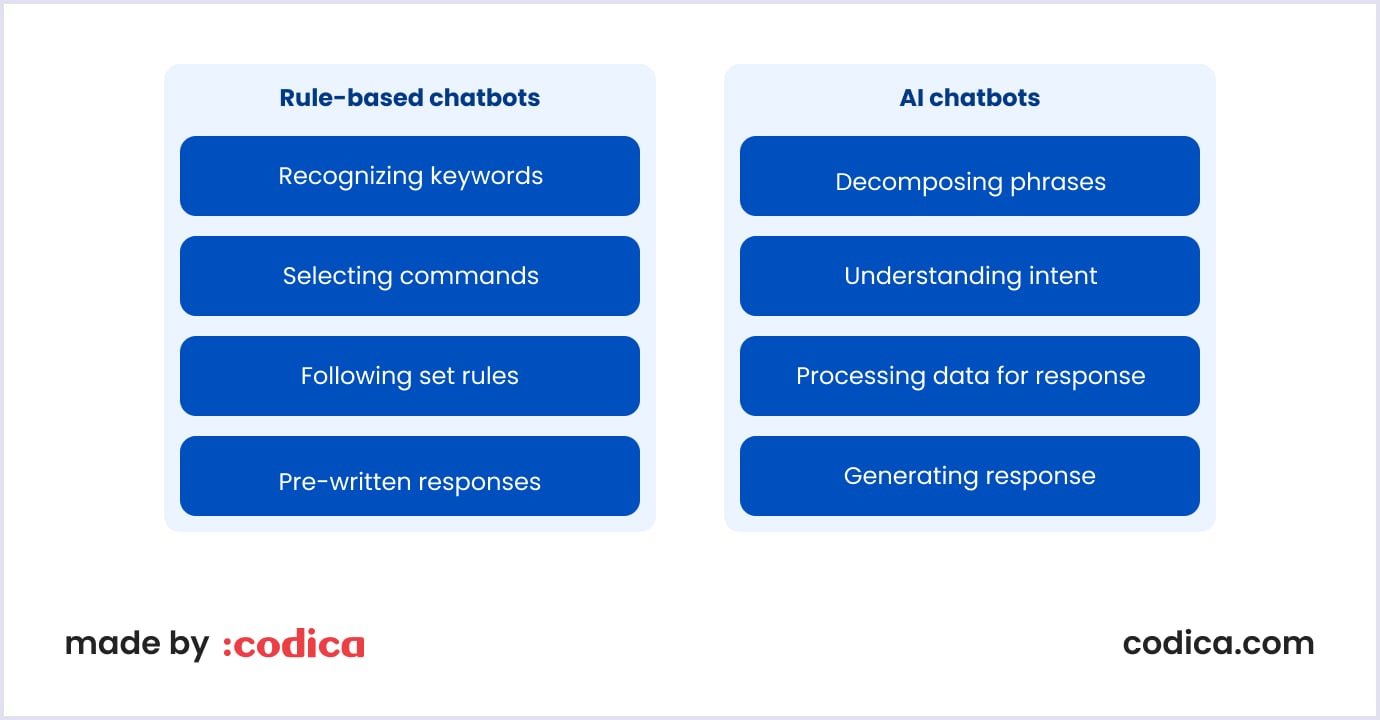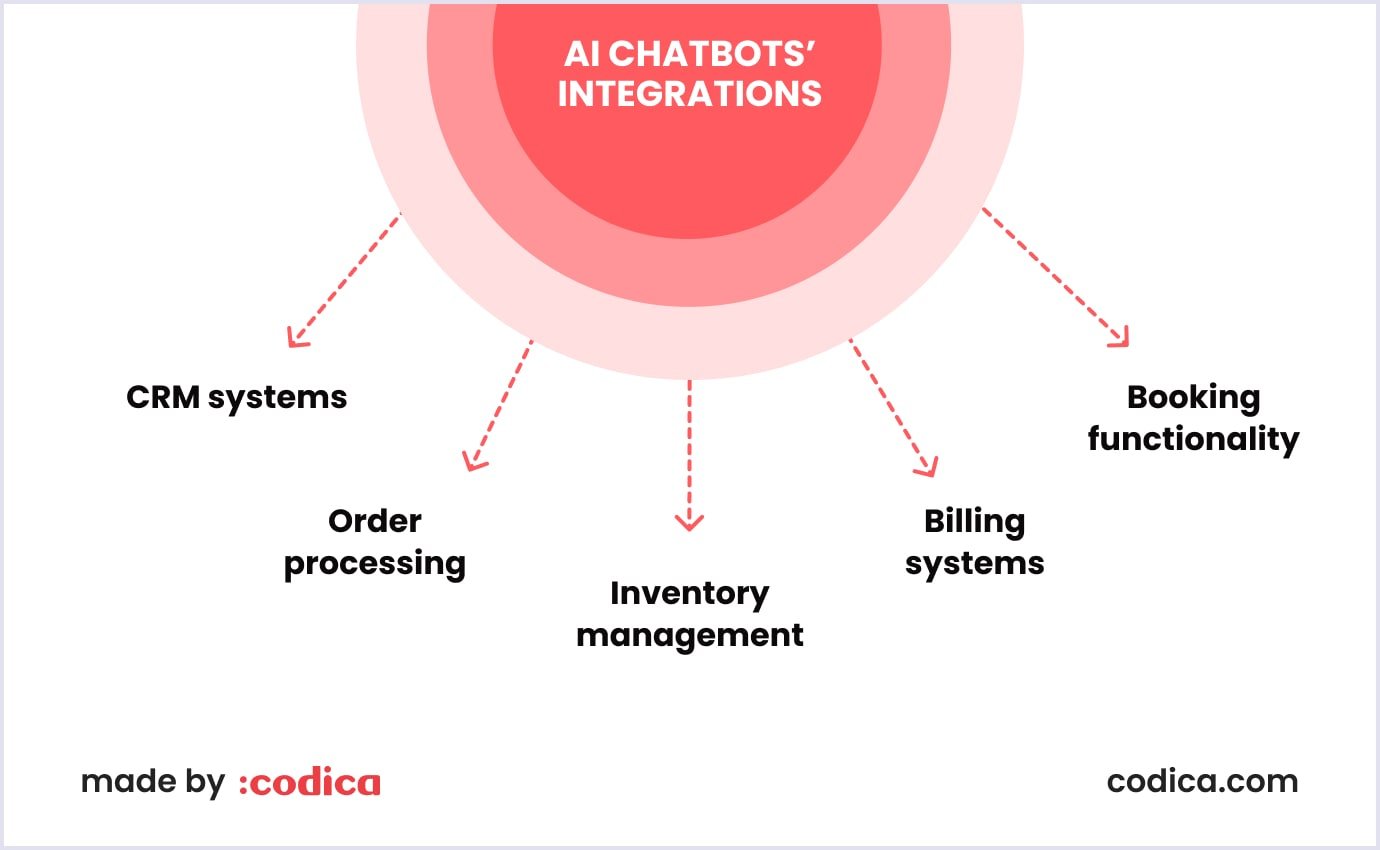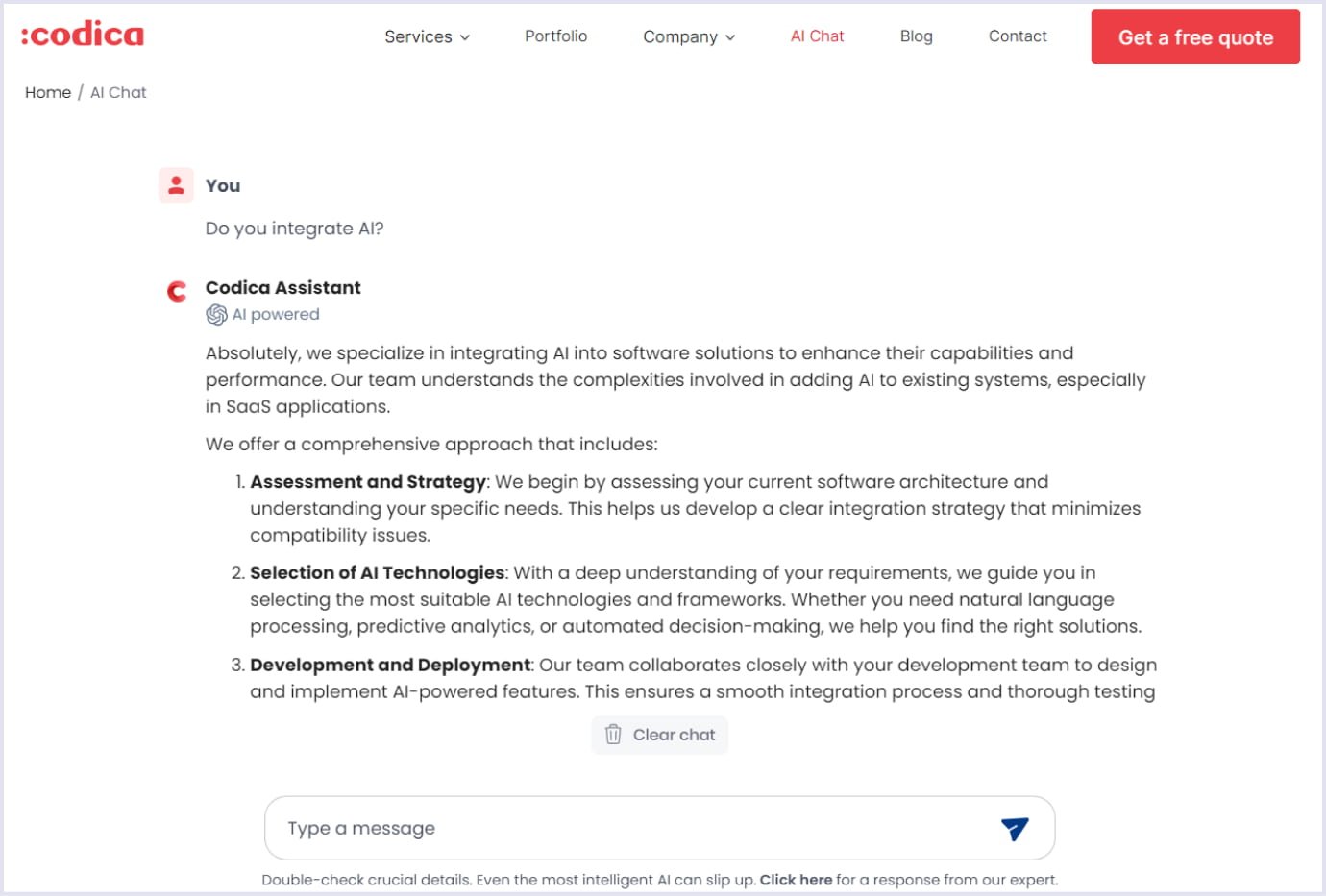Chatbots have gone a long way in services and companies. Now that they are powered by AI, they have become even more sophisticated. Thanks to AI techniques as part of AI chatbot features 2024, you can make conversations more human-like and swift. These capabilities make AI chatbots a helpful tool for connecting with your customers. You can also refine your business operations with AI chatbots.
If you are considering introducing an AI chatbot into your business processes or services, this post is for you. We explore what features AI chatbots should include to make the customer experience enjoyable.
How AI chatbots work: a brief overview
Regular chatbots are not new in business. Meanwhile, AI chatbots bring automated answers to a whole new level.
More enterprises adopt AI chatbots for their services and operations. Thus, customers and teams gain better and faster replies to their questions. Gartner predicts that traditional search engine volume will drop 25% by 2026 due to AI chatbots and other virtual assistants.
So, what are the main features of chatbots? The basic flow of a rule-based chatbot includes receiving an input, processing it, and giving a reply based on the options from a database.
AI makes chatbots smarter. They can correct spelling, interpret grammar and synonyms, and understand the context of the question. Thus, AI chatbots can process complex queries, understand user intent, and reply regarding the emotional context of the input. These advanced capabilities bring versatility and customer engagement with chatbots.

Let’s discover how AI techniques help chatbots deal with complex tasks with better efficiency.
Feature 1: Natural language processing (NLP)
This technology helps chatbots understand, process, and interpret the meaning of your text or speech. Chatbots use it to break down messages into smaller parts. This way, chatbots divide human speech into simple entities and recognize patterns.
NLP enables chatbots to grasp not only the meaning of text or speech elements but also the intent. Thus, when you ask, "Can I book a table for two?" or "Is there a spot for two available?" the chatbot knows what you mean. It will catch the meaning and understand that you want to reserve a table for two people.
Thanks to the implementation of NLP technology, AI chatbots can add a human touch to conversations. Chatbot natural language processing gives the ability to interpret language and leads to relevant responses. Moreover, chatbots can communicate in different styles and answer follow-up questions accurately. So, NLP-enabled conversations are smooth and provide the help needed.
You may also like: AI Pricing: How Much Does AI Cost in 2024?
Feature 2: Machine learning and adaptability
Machine learning is a term that unites different techniques of using algorithms for pattern recognition. Chatbot machine learning capabilities allow user behavior, feedback, and queries to be analyzed. Over time, chatbots learn more patterns and can deliver better answers. Even if unusual or new inputs appear, chatbots with AI integration recognize the actual intent. This is possible based on previous interactions.
AI chatbots reply to many users. So, bots recognize frequently asked questions and nuances in language. Based on this data, chatbots can predict user needs and provide personalized responses, keeping answers to the point.
ML also helps AI chatbots evolve. With each interaction, they learn more and gain experience in responding to queries. If a complex question arises, the chatbot leverages the past experience. This continuous growth makes chatbots a more helpful tool over time.

Feature 3: Multi-language support
Businesses can reach audiences across borders and meet different preferences by enabling multi-language backing in AI chatbots. There are several benefits you gain with the AI chatbot multi-language support:
- Reaching new markets and wider audiences. By offering support in different languages, you can connect to various customers. Thus, you increase your chances of improving sales and growth.
- Improving user experience. If your AI chatbot responds in different languages, it promotes a better connection with customers. Better satisfaction leads to trust in your brand.
- Best practices in inclusivity. In our diverse world, anyone should be respected. That is why you promote this approach by introducing support for customers in different cultures.
- Custom support across borders. With multi-language support, your chatbot delivers localized experiences. Thus, you provide a consistent brand message tailored to specific regions.
Feature 4: Omnichannel presence
Omnichannel is a norm today. It is fast and convenient to start browsing on the website and then switch to the app. Customers expect that from your brand. So, your chatbot will be a helpful tool in managing the omnichannel customer experience.
Thanks to the support of many channels, your AI chatbot will provide consistent help. Omnichannel chatbot presence will facilitate processing inquiries, managing orders, and solving any other problems your brand needs. Thus, your service will be swift and delightful for your customers.
To equip your chatbot with omnichannel support, select a robust platform, such as Dialogflow, Microsoft Bot Framework, or ManyChat. Also, using specific APIs helps you connect your chatbot with messengers and SMS gateways.
Read also: A Guide to Responsible AI: Best Practices and Examples
Feature 5: Integration with CRM and backend systems
Another foundational feature of AI chatbots is integration with customer relationship management (CRM) and operational systems. These integrations allow chatbots to retrieve the latest data from the systems and adjust their replies.
Thanks to CRM integration, your AI chatbot can learn about customer’s previous interactions. So, chatbots will reply based on preferences and purchases in the past context. With the chatbot CRM integration, customers get help without repeating past details.
Other chatbot integrations include order processing, inventory management, billing systems, and more. These integrations help you solve arising questions and issues and provide quick help. Intelligent chatbots solve customers’ questions on booking, returns, and information updates. So your team can deal with more strategic tasks.

Feature 6: Contextual awareness
AI chatbots can understand query context based on relevant training, APIs, and real-time learning through conversations. How does chatbot contextual awareness work? Chatbots can store details on previous interactions, preferences, and issues. So, in the next conversation with the same customer, your AI chatbot will base its replies on these past details.
Thanks to the memory of past interactions, chatbots do not start over again when the same customer inputs a query. Instead, the chatbot will start where the conversation left off. Also, the AI chatbot will adapt to the new inputs.
This feature ensures the continuity of interactions and relevant replies. Context-based conversations feel personal. So, they result in customer satisfaction and trust in your brand.
Related reading: AI-Personalized Shopping: How Tailored Experiences Boost Sales in Your Marketplace
Feature 7: Voice recognition and conversational AI
The integration of chatbot conversational AI and voice recognition brings versatility to handling queries. These technologies are especially helpful when your customers are in a hurry or have limitations in typing text.
Enabling voice queries makes the customer experience more intuitive and breezy. Also, processing such queries in voice-recognition chatbots is quick. This property is convenient when multitasking or using mobile devices.
For example, Mercedez-Benz User Experience (MBUX) uses voice control to help drivers easily access different commands. If you say, “Hey, Mercedez!” the system will be activated, and you can ask whatever you need on your way. Watch the introductory video on MBUX below.
Feature 8: Sentiment analysis
AI chatbots with sentiment analysis can recognize customers’ words as positive, negative, and neutral. Thanks to the AI’s mapping technique, chatbots can qualify the sentence emotion and respond accordingly. This feature helps AI chatbots provide emotionally intelligent replies and build better connections with customers.
Sentiment analysis in chatbots also allows for tailoring responses. For instance, if a customer tells about disappointment, a chatbot can empathize with them and help resolve issues. This property is beneficial when customers are frustrated.
With the proper sentiment analysis, the chatbot will acknowledge customer feelings. Thus, you show your customers that you value them and provide genuine assistance.
For example, Woebot, a mental health chatbot, can recognize signs of depression, anxiety, or stress thanks to sentiment analysis. Based on user inputs, the chatbot provides the necessary exploratory questions and options to answer. Thus, it guides users through their feelings.
Feature 9: Customizable chat flows and personalization
Depending on how your business helps customers, you can customize chat flows and other parameters of chatbot user experience optimization. Every step of your customer journey can be personalized to meet their needs. With chatbot customizable workflows, you can include specific questions to address queries about product search, purchases, returns, and more.
As your customers navigate your platform or product, AI chatbots can also provide context-based help. For instance, while a customer is on a product page, your chatbot will suggest relevant options. When a user is on the customer support page, the chatbot will provide answers to basic FAQs.
Moreover, you can even adjust the chatbot depending on your customers’ relationship with your brand. So, your chatbot personalization will include specific questions and relevant help to newcomers and returning customers.
For example, Seattle Ballooning has trained its AI chatbot with 31,000 conversations. The AI chatbot of this award-winning company covers frequent questions on hot air balloon rides, the location, best timings, and more. As their AI chatbot says, “Ask me anything!”

Feature 10: AI-powered analytics and reporting
AI chatbots process large amounts of information daily. Thus, integrating analytics will help you understand where you can improve your chatbot’s performance and your chatbot business automation. So, let’s break down which areas you can track with AI-powered chatbot analytics:
- Chatbot performance metrics. By analyzing the response time, completion rates, and accuracy of responses, businesses can evaluate the chatbot’s efficiency.
- Refining chatbot’s flow. If customers drop off at a specific point of conversation, it might show that improvement is necessary. So, additional training might be helpful.
- Discovering patterns in user queries and behavior. Tracking frequently asked questions, feedback, and unresolved queries will show the areas in which functionality and new capabilities can be added to the chatbot.
- Measuring ROI and business aspects. With AI analytics, you can see what impact your chatbot has on your business. You can track lead generation, conversion rates, and customer retention.
- Evolving with your customers’ needs. Spotting emerging customer needs will keep your chatbot as a helpful tool. Thus, it will provide relevant information and keep customers engaged.
How Codica leverages the power of AI chatbots
When providing AI development services, we know how proper training and feature sets are important to deliver a top-rated experience. That is why we have introduced Codica AI Assistant. This AI-powered chatbot will help you with questions about our services and successful projects.
Thanks to AI integrations, the answers provide comprehensive information. Codica Assistant leverages AI capabilities to offer nuanced and context-based responses. It gets better at understanding customer requests over time as it processes more conversations.
Feel free to ask our AI Assistant anything about your project and business needs.

Also, check out our portfolio for more successful projects we have delivered so far.
Summing up
AI-powered chatbots use advanced data processing techniques, increasing their responsiveness in customer service and automation. Thanks to NLP and ML, AI chatbots understand customers better and learn through interactions with them. By processing thousands and millions of requests over time, AI chatbots become enhanced helpers to serve customers on any device and regarding any issue.
AI chatbots support many languages, voice commands, and emotion recognition. With those advanced chatbot features, you improve customer experience and bring your business to a new level.
If you need help with AI chatbot implementation, contact us. We are eager to help you build an AI chatbot or custom software you need for your business.
